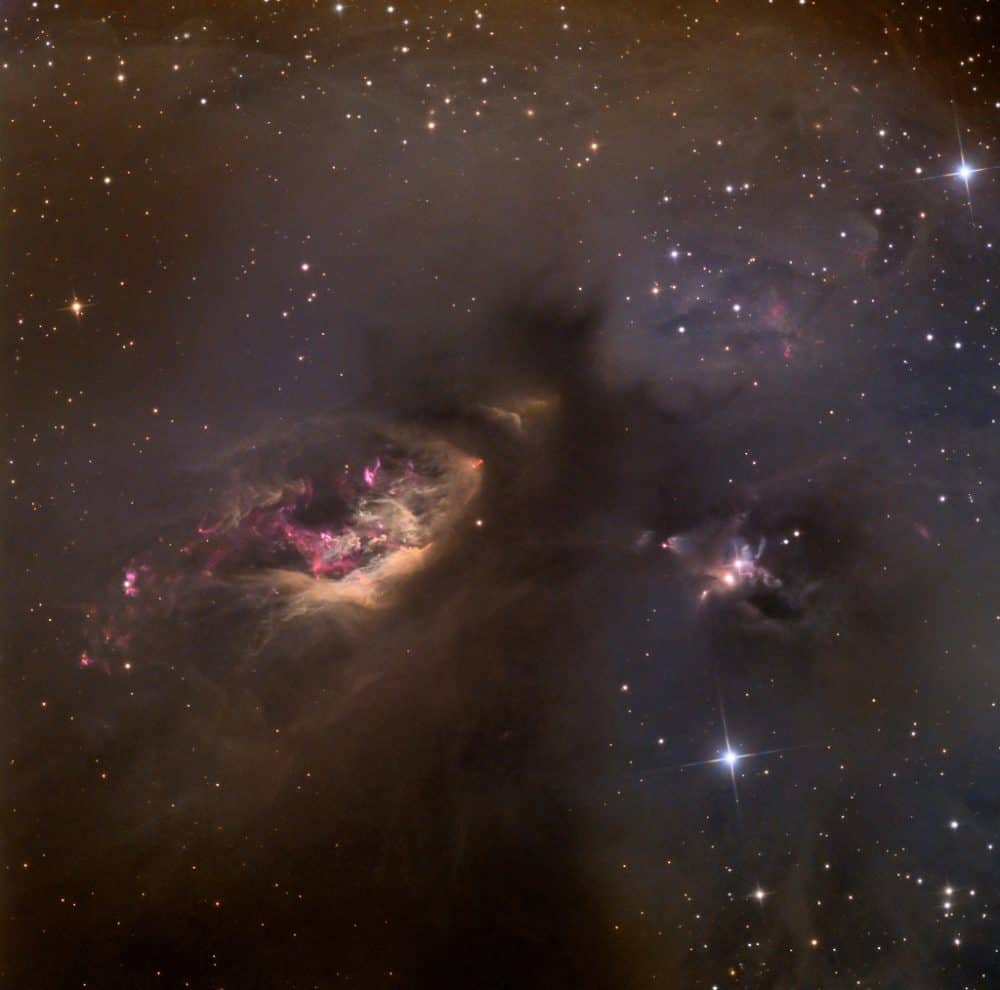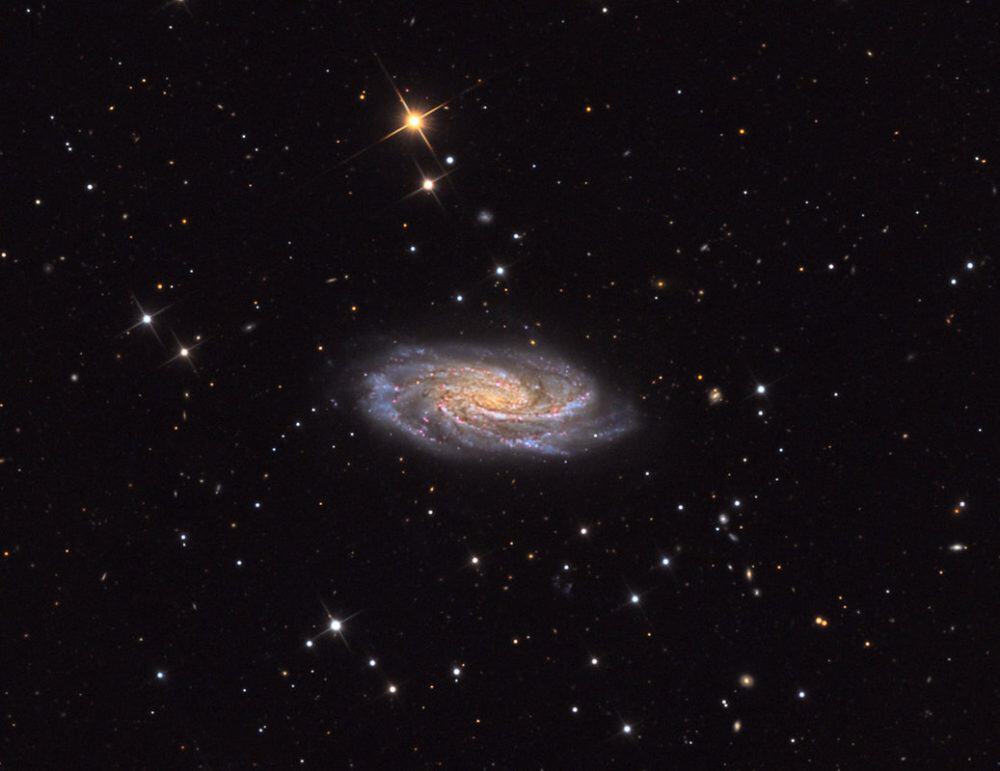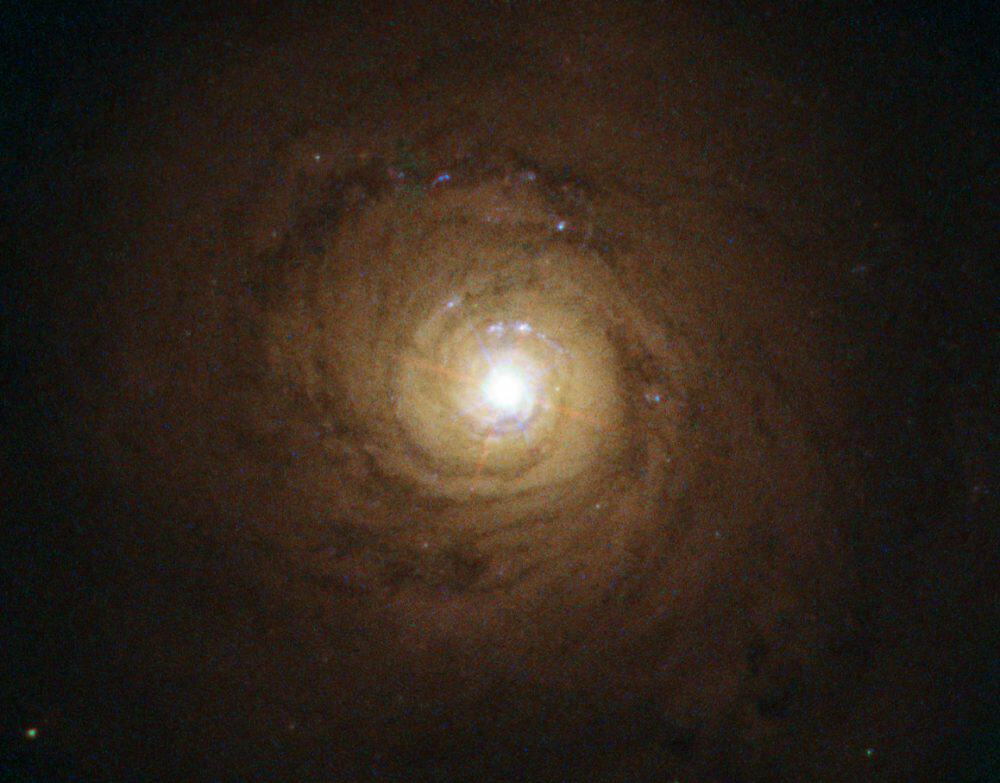Blog
This image shows Sharpless 239 (Sh2-239 or LBN 821, left), a reflection nebula surrounded by LDN 1551, a dark star forming cloud of gas and dust. The region stretches for nearly 3 light-years near the southern end of the Taurus molecular cloud, a region where active star formation is taking place, some 453 light-years away in the constellation of Taurus, near the border of the constellation Perseus.
LDN 1551 contains a total amount of material equivalent to about 50 times the mass of the Sun, and inside it you will find a dozen of pre-main sequence stars. Star formation activity has caused the mix of dust and colors in the nebulae.
Lots of embedded young stellar objects are spewing material in the surrounding interstellar medium, including (near the center of the image) a compact, red jet of shocked hydrogen gas near the position of the infrared source L1551 IRS 5, known to be a binary system of protostars surrounded by dust disks, separated by about 40 AU. Just below it are the broader, brighter wings of HH 102, one of the region’s many Herbig-Haro objects.
Herbig–Haro objects (HH) – after astronomers George Herbig and Guillermo Haro – are narrow jets of gas and matter ejected by young stars at speeds of 100 to 1000 kilometers per second that collide with the surrounding nebula, producing bright shock fronts that glow as the gas is heated by friction while the surrounding gas is excited by the high-energy radiation of nearby hot stars. They are ubiquitous in star-forming regions, and several are often seen around a single star. The stellar jets seem to form as the swirling cloud of dust and gas surrounding a new star escapes.
These objects are transient phenomena, lasting not more than a few thousand years. They can evolve visibly over quite short timescales as they move rapidly away from their parent star into the gas clouds in interstellar space.
The star formation in this area seems to proceed quickly as told by the rapid evaporation in the foreground. Soon even the deepest parts of this cloud will be blown away, and young clusters of stars will shine with exuberance.
more...James Marshall Hendrix (born Johnny Allen Hendrix; November 27, 1942 – September 18, 1970) was an American rock guitarist, singer, and songwriter. Although his mainstream career spanned only four years, he is widely regarded as one of the most influential electric guitarists in the history of popular music, and one of the most celebrated musicians of the 20th century. The Rock and Roll Hall of Fame describes him as “arguably the greatest instrumentalist in the history of rock music”.
Born in Seattle, Washington, Hendrix began playing guitar at the age of 15. In 1961, he enlisted in the U.S. Army and trained as a paratrooper in the 101st Airborne Division; he was granted an honorable discharge the following year. Soon afterward, he moved to Clarksville, Tennessee, and began playing gigs on the Chitlin’ Circuit, earning a place in the Isley Brothers‘ backing band and later with Little Richard, with whom he continued to work through mid-1965. He then played with Curtis Knight and the Squires before moving to England in late 1966 after being discovered by Linda Keith, who in turn interested bassist Chas Chandler of the Animals in becoming his first manager. Within months, Hendrix had earned three UK top ten hits with the Jimi Hendrix Experience: “Hey Joe“, “Purple Haze“, and “The Wind Cries Mary“. He achieved fame in the U.S. after his performance at the Monterey Pop Festival in 1967, and in 1968 his third and final studio album, Electric Ladyland, reached number one in the U.S.; it was Hendrix’s most commercially successful release and his first and only number one album. The world’s highest-paid performer, he headlined the Woodstock Festival in 1969 and the Isle of Wight Festival in 1970, before his accidental death from barbiturate-related asphyxia on September 18, 1970, at the age of 27.
https://www.youtube.com/watch?v=W3JsuWz4xWc
more...Lyle David Mays (born November 27, 1953) is an American jazz pianist and composer best known as a member of the Pat Metheny Group.Metheny and Mays composed and arranged nearly all of the group’s music, for which Mays has won eleven Grammy Awards.
Bill Evans‘ album Live in Montreux and Miles Davis‘ album Filles de Kilimanjaro were important influences on his formation as a jazz musician. He graduated from the University of North Texas after attending the University of Wisconsin-Eau Claire. He composed and arranged for the One O’Clock Lab Band and was the composer and arranger of Grammy-nominated album Lab 75.
After leaving North Texas, Mays toured with Woody Herman‘s group for approximately eight months. In 1974, he met Pat Metheny with whom he later founded the Pat Metheny Group. Mays has won eleven Grammy Awards with the Pat Metheny Group and has been nominated for four others for his own work.
In an interview with JAZZIZ magazine in 2016, Mays revealed his current career as a software manager.
In the Pat Metheny Group, Mays provides arrangements, orchestration, and the harmonic and metric backbone of the group’s musical signature. He occasionally performs on electric guitar as well. He played trumpet on the songs “Forward March” and “Yolanda You Learn” from the album First Circle (1984) and during the tour for that album
more...Randal Edward Brecker (born November 27, 1945) is an American trumpeter, flugelhornist, and composer. His versatility in different musical genres has made him a sought-after player, equally accomplished in playing jazz, rock, and R&B. He has also worked as a studio player for many famous musicians. He has performed or recorded with Stanley Turrentine, Billy Cobham, Larry Coryell, Bruce Springsteen, Lou Reed, Sandip Burman, Charles Mingus, Blood, Sweat & Tears, Horace Silver, Frank Zappa, Parliament-Funkadelic, Chris Parker, Jaco Pastorius, Eliane Elias, Dire Straits, Todd Rundgren, Blue Öyster Cult, Richard Barone, Spyro Gyra, Barbara Dennerlein and many others. In his formative years, Brecker studied trumpet with Bill Adam at Indiana University.
Danongan Kalanduyan was a master of all aspects of the Mindanao tribal style of kulintang music and an essential artistic figure in practically all major Filipino-American communities for several decades.
more...https://www.youtube.com/watch?v=Yy0SJco8wDg
more...NGC 3672 is a spiral galaxy of the Hubble type SA (s) c in the constellation Becher south of the celestial equator , which is estimated to be 100 million light-years away from the Milky Way .
The object was discovered by astronomer William Herschel on March 4, 1786 using its 18.7-inchtelescope and later recorded by Johan Dreyer in the New General Catalog .
more...Tina Turner (born Anna Mae Bullock; November 26, 1939) is an American-born Swiss singer-songwriter, dancer, and actress. Turner rose to international prominence as a featured singer with Ike Turner‘s Kings of Rhythm before recording hit singles both with Ike and as a solo performer. One of the world’s best-selling artists of all time, she has been referred to as The Queen of Rock ‘n’ Rolland has sold more than 200 million records worldwide to date. She is noted for her energetic stage presence, powerful vocals, and career longevity. Turner held a Guinness World Record for the largest paid audience (180,000) for a solo performer.
Anna Mae Bullock was born to a small family in Nutbush, Tennessee. Growing up throughout the Southeastern United States, she began singing in local church choirs. She began her career in 1958 as a featured singer with Ike Turner‘s Kings of Rhythm, first recording under the name “Little Ann”. Her introduction to the public as Tina Turner began in 1960 as a member of the Ike & Tina Turner Revue. Success followed with a string of notable hits credited to the duo, including “A Fool in Love“,“It’s Gonna Work Out Fine“, “River Deep – Mountain High” (1966), “Proud Mary” (1971), and “Nutbush City Limits” (1973), a song that she wrote. In her autobiography, I, Tina (1986), she revealed several instances of severe domestic abuse against her by Ike Turner prior to their 1976 split and subsequent 1978 divorce. Raised a Baptist, she became an adherent of Nichiren Buddhism in 1973, crediting the spiritual chant of Nam Myoho Renge Kyo, which Tina says helped her to endure during difficult times.
https://www.youtube.com/watch?v=hzQnPz6TpGc
more...Jim Mullen (born 26 November 1945) is a Glasgow-born jazz guitarist with a distinctive style, like Wes Montgomery before him, picking with the thumb rather than a plectrum.
It was while both musicians were touring the United States with AWB in the mid-70s that Mullen met tenor saxophone player Dick Morrissey, and throughout the 1980s, he found critical notice as joint leader of the British jazz funk band Morrissey–Mullen. Record producer Richard Niles, who produced the band’s sixth album, It’s About Time, later produced three solo albums for Mullen.
Mullen has also played and recorded with, among others, Mose Allison, Hamish Stuart, Joanna Eden, Tam White, Claire Martin, Mike Carr, Jimmy Witherspoon, Dave O’Higgins and Georgie Fame, Sinan Alimanović, David Tughan and Frank Holder. Mullen has recorded as part of The AllStars, a collective of session musicians on their Paul McCartney-produced album All About the Music, alongside special guests Jocelyn Brown, Hamish Stuart and Angelo Starr.
more...Robert “Bobby” Sharp (born November 26, 1924 in Topeka, Kansas, † January 28, 2013 in Alameda, California ) was an American musician (piano, vocals) and songwriter, who among other things, the song Unchain My Heart wrote.
Sharp spent his childhood in Lawrence (Kansas) before moving to Los Angeles, where he lived with his grandparents during the Great Depression , while his parents, Louis and Eva Sharp, aspired to a concert tenor or athlete career in New York. In 1936, at the age of twelve, he lived with his parents in New York City. Her apartment on Edgecombe Avenue on Harlem’s Sugar Hill was a meeting place for prominent figures of the Harlem Renaissance; These included Walter White, the founder of the civil rights organization NAACP, Roy Wilkins, longtime NAACP chairman, and Aaron Douglas, an African-American artist also from Topeka. In the immediate vicinity lived Duke Ellington .
In 1943 Sharp served in the US Army in the 372nd Infantry Regiment , which was stationed in New York and Fort Breckenridge (Kentucky). After his release from the army, he studied music at the Greenwich House Music School and then at the Manhattan School of Music harmony, music theory and piano. An important mentor at this stage was bandleader Sy Oliver , a friend of the Sharp family. In the following years, Sharp tried to sell his own songs on Broadway and Tin Pan Alley; a first success was 1956 Baby Girl of Mine , which he recorded with orchestral accompaniment for the label Wing and was later covered by Ruth Brown . The song Last Night in the Moonlight he recorded under his own name for the small label Destiny. In 1960 he signed a record deal with Epic Records.
In the 1950s and 1960s his songs were u. a. Recorded by Sarah Vaughan , Sammy Davis, Jr. and most of all by Ray Charles . This played in 1961, the first version of Sharp’s most famous song Unchain My Heart , the cover versions of Trini Lopez and Joe Cocker (1987) followed. Bobby Sharp had sold the copyright of the song for only $ 50 to the musician and composer Teddy Powell , who then insisted on his co-authorship. Sharp sold his share to Powell in 1963 for only $ 1,000. In 1987, Sharp renewed the exploitation rights to the song, shortly before Joe Cocker successfully covered it.
more...https://www.youtube.com/watch?v=rn56jbqREAU
more...NGC 5548 is a Type I Seyfert galaxy with a bright, active nucleus. This activity is caused by matter flowing onto a 65 million solar mass (M☉) supermassive black hole at the core. Morphologically, this is an unbarred lenticular galaxy with tightly-wound spiral arms, while shell and tidal tail features suggest that it has undergone a cosmologically-recent merger or interaction event. NGC 5548 is approximately 245 million light years away and appears in the constellation Boötes. The apparent visual magnitude of NGC 5548 is approximately 13.3 in the V band.
In 1943, this galaxy was one of twelve nebulae listed by American astronomer Carl Keenan Seyfert that showed broad emission lines in their nuclei. Members of this class of objects became known as Seyfert galaxies, and they were noted to have a higher than normal surface brightness in their nuclei. Observation of NGC 5548 during the 1960s with radio telescopes showed an enhanced level of radio emission.Spectrograms of the nucleus made in 1966 showed that the energized region was confined to a volume a few parsecs across, where temperature were around 14000 K and the plasma had a dispersion velocity of ±450 km/s.
more...Nat Adderley (November 25, 1931 – January 2, 2000) was an American jazz trumpeter. He was the younger brother of saxophonist Julian “Cannonball” Adderley, whom he remained very close to in his career but under whose shadow he lived for most of his life.
Adderley’s “Work Song” is a jazz standard which also became a success on the pop charts after singer Oscar Brown Jr. wrote lyrics for it.
Nathaniel Carlyle Adderley was born in Tampa, Florida, but moved to Tallahassee when his parents were hired to teach at Florida A&M University. His father played trumpet professionally in his younger years, and he passed down his trumpet to Cannonball. When Cannonball picked up the alto saxophone, he passed the trumpet to Nat, who began playing in 1946. He and Cannonball played with Ray Charles in the early 1940s in Tallahassee and in amateur gigs around the area.
more...Paul Desmond (born Paul Emil Breitenfeld, November 25, 1924 – May 30, 1977) was an American jazz alto saxophonist and composer, best known for his work with the Dave Brubeck Quartet and for composing that group’s biggest hit, “Take Five“. He was one of the most popular musicians to come out of the cool jazz scene.
In addition to his work with Brubeck, he led several groups and collaborated with Gerry Mulligan, Chet Baker, Jim Hall, and Ed Bickert. After years of chain smoking and poor health, Desmond succumbed to lung cancer in 1977 after a tour with Brubeck.
Desmond was born Paul Emil Breitenfeld in San Francisco, California, in 1924, the son of Shirley (née King) and Emil Aron Breitenfeld. His father was from a Jewish family from Bohemia and Austria, and his mother was Catholic; throughout his life, Desmond was unsure of his father’s background.
more...William Henry Joseph Bonaparte Bertholoff Smith (November 25, 1897– April 18, 1973), also known as “The Lion“, was an American jazzpianist and one of the masters of the stride style, usually grouped with James P. Johnson and Thomas “Fats” Waller as the three greatest practitioners of the genre in its golden age, from about 1920 to 1943.
William Henry Joseph Bonaparte Bertholoff was born in Goshen, New York. His mother and grandmother chose the names to reflect the different parts of his heritage: Joseph after Saint Joseph (Bible), Bonaparte (French), Bertholoff (biological father’s last name), Smith (added when he was three, his stepfather’s name), and William and Henry which were added for “spiritual balance”.
In his memoir he reports that his father, Frank Bertholoff, was Jewish. Willie was at least somewhat conversant in Yiddish, as he demonstrated in a television interview late in his life. Willie’s mother, Ida Oliver, had “Spanish, Negro, and Mohawk Indian blood”. Her mother, Ann Oliver, was a banjo player and had been in Primrose and West minstrel shows (Smith also had two cousins who were dancers in the shows, Etta and John Bloom).
more...Poland
A metaphysical story about the Carpathian village. Village, like in the old days, inhabited by Bukovina highlanders, Hutsuls, Jews, Gypsies, Polish, Romanians, Hungarians and many more from the abundance of the Transcarpathian cultures.
more...a beautiful galaxy located approximately 40 million light-years away in the constellation of Dorado (The Dolphinfish). NGC 1566 is an intermediate spiral galaxy, meaning that while it does not have a well-defined bar-shaped region of stars at its center — like barred spirals — it is not quite an unbarred spiral either.
more...Theodore Shaw Wilson (November 24, 1912 – July 31, 1986) was an American jazz pianist. Described by critic Scott Yanow as “the definitive swing pianist”, Wilson’s sophisticated and elegant style was featured on the records of many of the biggest names in jazz, including Louis Armstrong, Lena Horne, Benny Goodman, Billie Holiday, and Ella Fitzgerald. With Goodman, he was one of the first black musicians to appear prominently with white musicians. In addition to his extensive work as a sideman, Wilson also led his own groups and recording sessions from the late 1920s to the 1980s.
Wilson was born in Austin, Texas, on November 24, 1912. He studied piano and violin at Tuskegee Institute in Tuskegee, Alabama. After working in Speed Webb‘s band, with Louis Armstrong, and also understudying Earl Hines in Hines’s Grand Terrace Cafe Orchestra, Wilson joined Benny Carter‘s Chocolate Dandies in 1933. In 1935, he joined the Benny Goodman Trio (which consisted of Goodman, Wilson and drummer Gene Krupa, later expanded to the Benny Goodman Quartet with the addition of Lionel Hampton). The trio performed during the big band‘s intermissions. By joining the trio, Wilson became one of the first black musicians to perform prominently in a racially integrated group.
more...More Posts
- Allen Eager
- Max Roach
- World Music with Ernest Honny
- Daily Roots with Israel Vibration
- Cosmos NGC 2014/2020
- Jimmy Page
- Joan Baez
- Bucky Pizzarelli
- Ofelya Hambardzumyan
- Kenny Clarke
- Dr. Hepcat
- World Music with Dorota Barová
- Daily Roots with Mike Brooks and Jah Lloyd
- Cosmos NGC 7000
- David Bowie
- Dave Weckl
- Elvis Presley
- Tampa Red
- World Music with Sinan Cem Eroglu
- Daily Roots with Kailash



